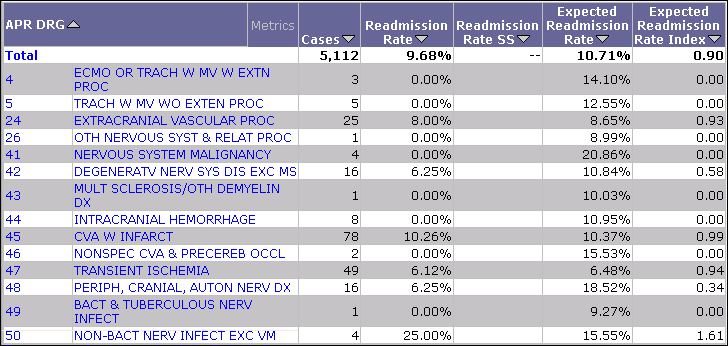Readmission Facility 3M™
This analysis retrieves readmissions regardless of APR DRG. Use this analysis to determine how well your facility performs compared to the normative values in the Perspective Database. This analysis quickly compares your facility's severity-of-illness-adjusted readmission rate to the expected readmission rate in Perspective Database. You can compare overall performance and performance across all disease categories, such as APR DRGs or APR DRG Business Lines. You can quickly locate any disease categories that are performing better or worse than the expected value by analyzing the index measure.
Use this analysis in discharge planning to identify areas for new clinical pathways and to analyze effectiveness of existing clinical pathways. For example, if readmit rates are high or are on the rise as a result of process improvement initiatives, organizations might determine the need for discharge planning, referrals to home health, additional patient education, etc. If ALOS is comparatively low and readmit rate is high, this could be indicative of a process initiative that is creating a negative impact. This could also indicate that patients are being discharged too early.
Select Population Tab:There are 3 required prompts that you must select before running this analysis. Required Prompts:
Optional Prompts:
Set Up Analysis Tab:Row Header Prompt
|
Readmission Rate Methodology on this Analysis
The Readmission Analysis compares your facility's severity-of-illness-adjusted readmission rate to the normative values in the Perspective Database.
The readmission rate is calculated by identifying patients readmitted within 30 days regardless of the APR DRG. The readmission flag is denoted on the first admission. For example, a patient discharged on 01//02 for APR DRG 302 (Knee Joint Replacement) and then admitted on 01/15/02 for APR DRG 139 (Other Pneumonia) will be flagged as a readmission on the first admission of 01//02. Therefore, the readmission rate will be calculated based on the APR DRG 302 (Knee Joint Replacement) admission.
The following patients are excluded from the readmission rate calculation:
- Skilled Nursing Facility Patients (Perspective Database Patient Type = 10)
- False Labor Patients - Patients with principal, admitting or secondary ICD Codes of:
|
ICD-10 |
|---|
|
O47.00 - FALSE LABOR BEFORE 37 COMPLETED WEEKS OF GESTATION, UNSPECIFIED TRIMESTER O47.9 - FALSE LABOR, UNSPECIFIED |
|
O47.02 - FALSE LABOR BEFORE 37 COMPLETED WEEKS OF GESTATION, SECOND TRIMESTER O47.03 - FALSE LABOR BEFORE 37 COMPLETED WEEKS OF GESTATION, THIRD TRIMESTER O47.1 - FALSE LABOR AT OR AFTER 37 COMPLETED WEEKS OF GESTATION |
|
O60.00 – PRETERM LABOR WITHOUT DELIVERY, UNSPECIFIED TRIMESTER O60.02 – PRETERM LABOR WITHOUT DELIVERY, SECOND TRIMESTER O60.03 – PRETERM LABOR WITHOUT DELIVERY, THIRD TRIMESTER |
For more information about Readmission Methodologies, refer to the QualityAdvisor Methodologies Guide.
Data on This Analysis
This analysis uses the 3M™ risk adjustment methodology to produce its Expected rates. The Expected Readmission Rate Index measure represents the ratio of the facility's actual measured value divided by the facility's expected value. The expected value represents the value that the facility would expect if it performed at the Perspective Database APR DRG severity-of-illness average for each discharge.
The Readmission Rate
SS column indicates statistical significance. The Readmission Rate is statistically significant if the difference between the percentage of
readmissions for a facility and the expected percentage of readmission
for a particular APR DRG. A  denotes that the variation is statistically
significant (not due to chance) with 99% certainty. If there is no value in this column, that means
that either the variation is not statistically significant or the number
of cases is less than 25 and statistical significance was not evaluated.
denotes that the variation is statistically
significant (not due to chance) with 99% certainty. If there is no value in this column, that means
that either the variation is not statistically significant or the number
of cases is less than 25 and statistical significance was not evaluated.
The test of significance is an important statistic to use when analyzing severity-of-illness-adjusted data. Often, decisions are made based on such data, and it is important to identify whether the reported variances are due to chance or performance differences.
Analysis Sample

Drilling
You can drill on this analysis. Drilling allows you to change the analysis type. Although many different attributes can be drilled to from this analysis, it is important to note that all expected values represent the value your facility and peer group would expect if they performed at the Perspective Database APR DRG severity-of-illness average for each discharge.
Drilling to Patient Details
This analysis allows you to drill to the Facility All Patient Detail Analysis, which includes all the patients that match the criteria entered at the prompts.
To access this drilldown, right-click on the column header or the rows and select Drill > Drill to Patient Detail Analysis > Facility All Patient Detail Analysis.
For more details, see Facility All Patient Detail Analysis.